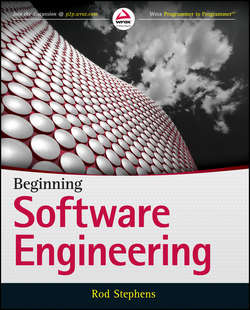Читать книгу Beginning Software Engineering - Stephens Rod - Страница 4
На сайте Литреса книга снята с продажи.
INTRODUCTION
WHO SHOULD READ THIS BOOK?
ОглавлениеEveryone involved in any software development effort should have a basic understanding of software engineering. Whether you're an executive customer specifying the software's purpose and features, an end user who will eventually spend time working with (and reporting bugs in) the finished application, a lead developer who keeps other programmers on track (and not playing too much Flow Free), or the guy who fetches donuts for the weekly meeting, you need to understand how all the pieces of the process fit together. A failure by any of these people (particularly the donut wallah) affects everyone else, so it's essential that everyone knows the warning signs that indicate the project may be veering toward disaster.
This book is mainly intended for people with limited experience in software engineering. It doesn't expect you to have any previous experience with software development, project management, or programming. (I suspect most readers will have some experience with donuts, but that's not necessary, either.)
Even if you have some familiarity with those topics, particularly programming, you may still find this book informative. If you've been focusing only on the pieces of a project assigned to you, you still need to learn about how the pieces interact to help guide the project toward success.
For example, I had been working as a programmer for several years and even taken part in some fairly large development efforts before I took a good look at the development process as a whole. I knew other people were writing use cases and deployment plans, but my focus was on my piece of the project. It wasn't until later, when I started taking a higher-level role in projects that I actually started to see the entire process.
This book does not explain how to program. It does explain some techniques programmers can use to produce code that is flexible enough to handle the inevitable change requests, easy to debug (at least your code will be), and easy to enhance and maintain in the future (more change requests), but they are described in general terms and don't require you to know how to program.
If you don't work in a programming role, for example if you're an end user or a project manager, you'll hopefully find that material interesting even if you don't use it directly. You may also find some techniques surprisingly applicable to nonprogramming problems. For example, techniques for generating problem-solving approaches apply to all sorts of problems, not just programming decisions. (You can also ask developers, “Are you using assertions and gray-box testing methods before unit testing?” just to see if they understand what you're talking about. Basically, you're using gray-box testing to see if the developers know what gray-box testing is. You'll learn more about that in Chapter 8, “Testing.”)
